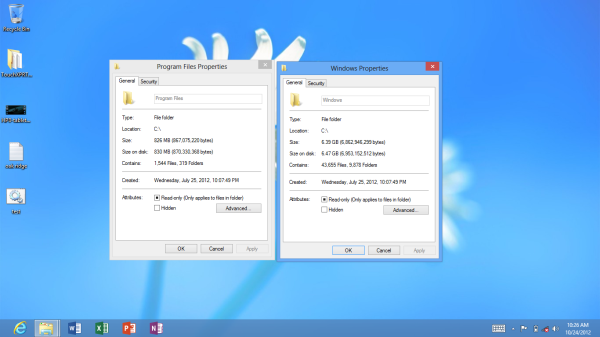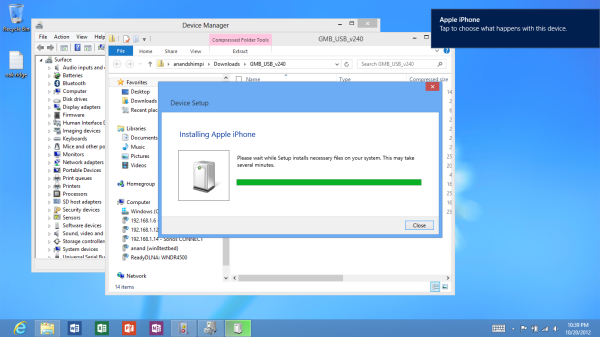The Windows RT Review
by Vivek Gowri & Anand Lal Shimpi on October 25, 2012 12:00 PM EST- Posted in
- Windows RT
- Operating Systems
- Microsoft
- Mobile
- Windows 8
- Tablets
UI Performance, Storage, and USB Compatibility
by Vivek Gowri and Anand Shimpi
With Windows Phone 7, Microsoft did a great job of taking generation-old hardware and delivering a great user experience in spite of any silicon-level deficiencies. So naturally, with the new Windows UI, we were expecting a very smooth UI regardless of the underlying hardware. And they’ve most certainly delivered on that.
Animation frame rates are consistently good all the way through the UI, easily delivering what appears to be 60 fps for UI transitions. When pushed, Modern UI seems more likely to completely drop animations versus dropping frames, which eliminates the choppy experience you sometimes find in Android. It isn’t a common occurrence, the experience is generally very fluid. This kind of consistently smooth UI is what Google has been striving for in every recent release of Android, dedicating the release of 4.1 to eliminate the dropping of frames in even basic interactions. Scrolling, swiping, snapping, app switching - it doesn’t really matter what you’re doing, RT is just really smooth. Combined with the fluidity of the gestures, the entire system just feels like liquid, there are just no real slowdowns even running on a no-longer impressive SoC like Tegra 3.
| Application Launch Time Comparison | |||||||
| Boot | Web Browser | Maps | Games Center / Xbox | ||||
| Apple iPad (3rd gen) | 32.0s | 1.0s | 2.4s | 1.1s | 1.9s | ||
| Microsoft Surface | 27.7s | 2.6s | 7.1s | 5.0s | 5.0s | ||
But there is one area that RT struggles in, and it’s something that was an issue in Windows Phone 7 too - application launch times. Anand included this table in his Surface review, and it shows that boot performance is decent, but the 3rd generation iPad just kills it in application loading. The new A6X-infused 4th gen iPad probably widens that gap too, so it’s a pretty stark difference. It’s something that Microsoft needs to really focus on when updating the OS, because it’s easily one of the most glaring flaws in an otherwise stellar interface.
From a storage standpoint, the OS takes up between 6.5 and 7.5GB of space (Anand measured 6.47GB on Surface, I measured 7.35GB on the VivoTab RT) and Office takes up another 750-850MB (830MB for Surface, 749MB for the ASUS), so you’re looking at 7.5-8GB of NAND dedicated to the OS. On my 32GB VivoTab RT, I had 25.3GB of storage to start with, so after Windows and Office, I was looking at 17GB left over for programs and documents. That’s....not a lot - a bit of music, a decent selection of applications, a couple of videos, and pretty soon I’m looking at less than 10GB of storage left over. Thankfully, we’re seeing microSD slots on a lot of the more prominent Windows RT slates, so if you run out of room, you could theoretically toss in a 32GB or 64GB microSDXC card. Depending on how much data you plan on storing, I think you can get away with the lesser internal NAND and some microSD cards.
It’s also pretty clear that there will not be a Windows RT slate shipped with less than 32GB of onboard NAND. If you’re holding out for a cheaper Windows RT device with less storage, like a 16GB tablet for $399, there’s almost no way that happens - it’s implausible to think that anyone would ship a tablet with less than 5GB of space left for data storage.
Another key detail in Windows RT is wide-ranging USB peripheral support. USB ports have been a common feature on 10” Android tablets, but device support was typically limited to flash drives and basic input devices. The goal with Windows RT was to bring the traditional Windows experience to tablets, so USB driver support is pretty important. It’s not as easy as on an x86 system, where most USB peripherals would just work, but even with more limited Windows-on-ARM drivers, it’s pretty decent overall.
USB drives obviously work as you’d expect them to. Even SATA to USB adapters worked fine when plugged into Surface. Other smartphones and tablets also worked, although their level of support varied. For example, you can plug in the iPhone 5 and have it come up as a supported device for moving pictures to/from. However USB tethering is not supported by the class driver included in Windows RT. You can even plug an iPad into Surface and get the same level of support. The few Android phones I tried to connect in MTP all worked as expected, though transfer rates off my Optimus 4X HD seemed on the slow side, likely a function of the phone’s internal eMMC.
Printer support is pretty decent, although the Epson Workforce 910 Anand tried didn’t actually have specific driver support under RT. Although development for the desktop side of Windows is limited, manufacturers can supply Windows RT drivers to enable support for some more obscure devices. Unfortunately when it comes to those devices you’ll have to play the waiting game as there’s simply not a lot of third party Windows RT drivers available for download today.












233 Comments
View All Comments
khanikun - Friday, October 26, 2012 - link
Think you hang out with a lot of kids, cause everyone I know doesn't promote games. They promote useful apps. Cardstar, vehicle traffic apps, gas prices around you apps, etc. Well, at least what I saw in the DC/Baltimore area.Maybe in middle-of-nowhere, where there is barely any traffic, 1 supermarket, 3 gas stations, they don't need such apps and just play games.
dysonlu - Friday, October 26, 2012 - link
Well, I guess you hang out with middle age people who drive gas guzzlers and trucks then. See what I did there, dick?Just take a look at the Apple App Store charts, mostly games and entertainment apps rule. Do some reading. It's not just coincidence that Angry Birds, Fruit Ninja, etc., became household names.
Oh and try to argue without insulting or degrading others. You may not be a kid but you should grow up.
designerfx - Thursday, October 25, 2012 - link
yeah this was never true, even for android and ios. it was a rumor started by....wait for it, wait for it..............Microsoft.
NeuroticNomad - Monday, October 29, 2012 - link
You ARE aware that Apple stopped accepting fart apps back in September of 2010... over 2 years (and 500,000 apps later), are you not?App Store count at the end of Aug 2010: Just under 250,000
Source: http://tech.fortune.cnn.com/2010/08/28/apple-app-s...
App Store count September 2010: 703,189
Source: http://148apps.biz/app-store-metrics/
Fart App Ban: September 2010
Source: http://www.engadget.com/2010/09/09/apples-app-stor...
NeuroticNomad - Monday, October 29, 2012 - link
Second link is for 2012, not 2010.appliance5000 - Thursday, November 1, 2012 - link
I find that disappointing.cappasay - Thursday, October 25, 2012 - link
Yesterday the latest report said 7k apps. I can't attest to their quality.. but your statement about taking "at least a year" for "tens of thousands of apps" seems a bit off.p05esto - Thursday, October 25, 2012 - link
How many stupid apps do you actualyl use? I installed about 20 apps when I first got my tablet and have hardly installed anything else. I surf the web mostly, check a little email and play checkers....that's about it!tbutler - Thursday, October 25, 2012 - link
I also think the review is being overly optimistic about Metro apps.The argument is that Windows 8 will have a huge install base, therefore developers will write Metro apps for Windows 8. But the review itself admits "for mouse-based navigation, you’re better off treating it as a glorified Start menu", and indeed the 'traditionalist' reply to Win8 critics seems to be "other than the Start screen, you can ignore Metro and just use it like you used Win7." If this is the way people are going to use it, the installed base argument is worthless; all those supposed millions of Windows 8 users are going to be in desktop mode, so there's no incentive to write Metro apps for them.
Metro app development is going to have to rise or fall on the strength of the tablet market, which is a much iffier prospect.
a5cent - Thursday, October 25, 2012 - link
I expect to see the market split between power users / IT workers and consumers.Professionals requiring the heavyweight software packages (MatLab, Maya, Photoshop, etc) will probably stick with the view that the start screen is nothing but a glorified app launcher.
After an adaptation period however, consumers will find themselves using Metro more and more often and at some point, desktop mode will become irrelevant for many, including those with laptop and desktop PC's. So I do think notebook/desktop sales will help strengthen the market for Metro app developers.